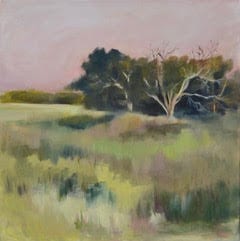
20″ x 20″ – Oil
Have you been to a doctor lately and heard the comment, “At your age…”? I have. It left me with a rather indignant feeling. I didn’t really feel old.
When my husband and I decided to move from Georgia to Texas for retirement years, I couldn’t help but hear the same words in my head, “At your age?…do you really think you can pack up this familiar studio and produce paintings in a new environment? At your age?…can you find new clients for paintings or new students of painting? At your age?… is it worth the effort to become valued as an artist in a new place?”
In almost two years, it has been, and still is, a struggle of networking, painting, seeking, learning, and pushing myself to settle into a new place. But the new relationships, the personal growth, the experiences and revelations are always worth the effort.
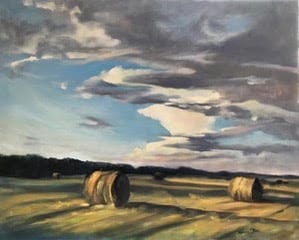
24″ x 30″ – Oil
As an “over 60” artist, I look back on my art journey and realize I did not begin growing in painting until my children went away to college. Painting filled the “empty nest.” That was about twenty years ago. When I retired several years ago from a 26 year career of teaching Art and Language Arts in Georgia public schools, I finally had time to focus on painting regularly in my backyard studio. Life was rocking along. I was involved with a local gallery, painting, selling, teaching, and having several solo shows. And then, our oldest son in Waco, Texas announced that he was not returning to Georgia and that we needed to “get out here before you get too old!” (There’s that “at your age” feeling). My husband said he always wanted to be a cowboy, so we began making plans for a long distance move.
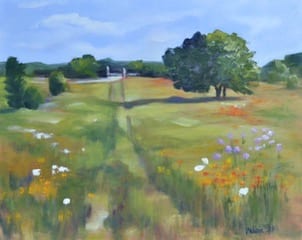
16″ x 20″ – Oil
“At my age,” I am here to tell you there is time for developing art skills after a transition like a move! I looked at retirement as moving from my first career to a second one, that of being a full-time artist, so I needed to report to work every day. Exercises like accepting challenges to paint outside for 30 days, attending workshops, finding communities of artist friends, blogging about the work, watching Lunch & Learn videos from OPA, keeping a sketchbook, and painting some more, will all sharpen skills and expand knowledge. And, the networking of posting on social media, attending art events, talking with people about your work, and listening to them, is also important for getting settled in your new location.
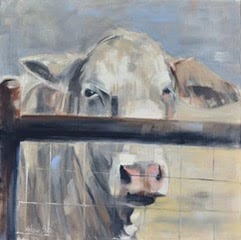
20″ x 20″ – Oil
Painting ‘en plein air’ has been a wonderful way to experience my new environment with all of my senses. We lived on a friend’s ranch for a year while we built our new home. Going outside daily to paint on 85 acres was a wonderful artist’s retreat for me. I became acquainted with Texas wildflowers I had never seen, so bright with color! The big Texas sky and the variety of clouds are a constant source of entertainment and challenge for this oil painter. And I had never had cows for neighbors before!
This past spring, Covid restrictions emptied the local Baylor University campus. A new painter friend and I began going weekly to paint in the tranquil, quiet, socially distanced locations around campus. From that, a Buildings of Baylor series reached a new following. Prints and notecards were suggested and were successful. The knowledge I gained from this is to find what is important to the people where you are. Paint what is important to you, but if you want to be valued in your new location, paint what is important to your new audience, also.
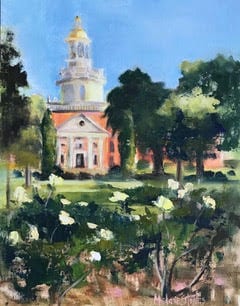
14″ x 11″ – Oil
Recently, a friend was talking with me about plein air painting. She asked, “What are some things you have learned from it that you can apply to life?” I couldn’t answer immediately. But as I’ve pondered, these thoughts come to mind:
- Things aren’t always perfect. The conditions we find ourselves painting in are often a surprise. We forget needed supplies and make do. Bugs are biting, sun is blazing, wind is blowing and yet, we adapt with creativity.
- We don’t always have to produce a finished product. Looking at the canvases as studies, rather than completed paintings freed me to just paint, learn, and enjoy the experience.
- Painting is therapy. When I am outside, listening to birds, using all five senses, I escape other stresses going on. It puts me in a meditative mode of gratitude.
- Delayed gratification is good. One of my workshop instructors, Laurel Daniel, emphasized holding all highlights to the end. It’s tempting to rush ahead to the good part and put the light in too soon, only to lose it in the mix of color. When we hold those highlights of white with a touch of lemon yellow until the end, they pop at just the right spot! Delayed gratification is something I want to remember to teach younger generations.
- Art is not instant. It takes years of learning, practice, mistakes, motivation and determination, at any age.
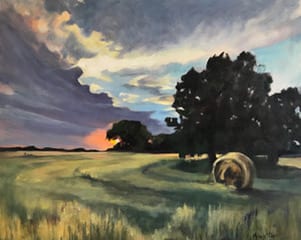
24″ x 30″ – Oil
“At my age” I enjoy painting life around me, interpreting the beauty I see, choosing what I want to paint, and sharing my thoughts with others through visual images and written words in a blog. Often my painting sessions turn into deep conversations with myself, often they turn into worship of The Creator, often they are therapy for the heavy turmoil of today’s world, often they are accompanied by my prayers.
Painting is my passion and brings purpose…even “at my age” and hopefully, in the ages to come!
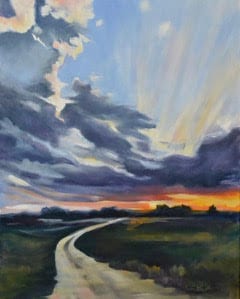
30″ x 24″ – Oil